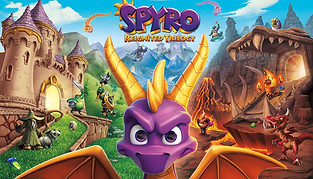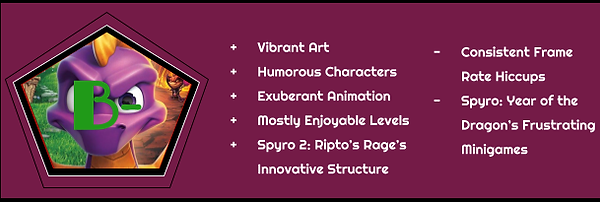REVIEW | Spyro Reignited Trilogy
Written by Michael Richardson
Published 25 January 2019
All trademarks are properties of their respective owners.
Opinions expressed in this review are of the reviewer alone.
Game Copyright 2018 Activision Publishing, Inc.
Available on PS4, X1, NS, PC
Reviewed on PS4
Burning Charge
Even twenty-four years since launch, the Playstation brand has yet to announce an official mascot. Spyro the Dragon, Jak and Daxter, Crash Bandicoot, and even Sly Cooper have all vouched for the throne, but no avail, and at this point, Sony is unlikely to name an official mascot. However, those aforementioned icons have recently undergone a resurgence through remasters and remakes, especially with Activision’s great Crash Bandicoot N. Sane Trilogy, which bundled all of Crash’s Playstation platformers onto one software. Given the meteoric success of the remake, it was only a matter of time before the industry’s favorite purple dragon, Spyro, soared onto modern consoles. Similar to the Crash remake, the Spyro Reignited Trilogy bundles all of Insomniac Games’ original Playstation outings: Spyro the Dragon, Spyro 2: Ripto’s Rage, and Spyro: Year of the Dragon. As a giant fan of three-dimensional platformers, I was excited to play Spyro’s original trilogy and examine why fans continue to rave for his installments. Having fully completed all three games in the Spyro Reignited Trilogy, I was impressed by how well Spyro’s gameplay and art translate to the modern era, but was taken aback by the gameplay frustrations and persistent technical issues I encountered during my thirty hours with the compilation.
To give a better understanding of Spyro’s original Playstation adventures, I am going to go through each game to highlight the strengths, weaknesses, and innovations of each installment. Lets get charging!
Spyro the Dragon
What is a gnorc to do when a dragon insults him? Well, turn all of his newfound enemies into statues, of course! Developer Insomniac Games’ first foray into Spyro’s universe starts just like that, with antagonist Gnasty Gnorc unleashing a spell that turns all of the dragons into statues, and it's up to the underdog Spyro to rescue his brethren and defeat Gnasty. Just like the original Spyro the Dragon set the tone for the rest of the series, the original Spyro sets the tone for the rest of the Reignited Trilogy. The first game establishes a vibrant, Pixar-like art direction that simply pops with lush grasses, colorful landscapes, and great texturing that bring Spyro’s worlds to life on modern hardware. Well voiced by Tom Kenny, Spyro himself reeks with charm through his expressive animation and funny one-liners. While his controls take a while to get used too and flying mostly ends up feeling like a chore, Spyro’s abilities to fly, jump, charge, and breathe fire to stomp his adversaries and collect gems make for a unique playstyle that I grew to enjoy overall.
However, with each game improving upon the foundation set by its predecessor to some degree, it’s unfortunate that performance struggles across all three games. The Reignited Trilogy consistently shuddered and seldom achieved thirty frames per second, which severely affected my experience. It bewilders me how remasters of twenty year old games are unable to achieve a solid frame rate, and Spyro’s poor performance drove me up a wall when I could hardly perceive where I was going to land on a platform.
In order to progress, Spyro must collect gems which are littered throughout stages in order to unlock new hub worlds. In the first installment, gems only serve as a way to progress, which felt like a missed opportunity compared to other games in the genre which reward, for example, extra levels or concept art for collectables. Therefore, I seldom felt satisfied whenever I obtained a gem. Each hub world culminates in a boss fight, and while each boss posed a unique platforming challenge, I found most of them largely unmemorable with how quick their fights ended up being. Additionally, while the worlds themselves were often fun to explore, few ended up resonating with me because of their repetitive color palates and music. Especially in these similar environments, I appreciated how Sparx, Spyro’s butterfly companion, can be used to guide the player towards missed collectables. However, vertical levels pose a challenge for Sparx across all three games, and are often where he feels the most imprecise. Trying to find the last few gems in these stages became a chore when Sparx pointed me towards a cryptic area, and I wish he was better programmed as a result. Also, the overreliance on egg thieves, which require Spyro to dash into them to obtain a dragon egg, always frustrated me with their dull challenge and unfathomably annoying voices.
Additionally, as one who is not particularly fond of racing challenges, I was shocked by how much I enjoyed the flight levels in Spyro the Dragon. Alongside its sequel, the original Spyro’s flight-specific levels revolve around the purple dragon conquering a series of obstacles under a strict time limit, such as scorching trains or zipping through rings. Spyro’s flight control blemishes are significantly alleviated in flying levels, creating smooth and fun environments that offer an unparalleled challenge compared to the rest of the game. Every time I conquered a flight level, I felt extremely satisfied and looked forward to how the next one would iterate on previous concepts. Furthermore, the original Spyro the Dragon sets a good, albeit unimpressive foundation for future sequels with an eclectic main protagonist and fun platforming challenges, but is hampered by repetitive level designs and a lack of use for collectables.
Spyro 2: Ripto's Rage
Spyro 2: Ripto’s Rage is by far my favorite game in the collection, alleviating my issues with the original Spyro to form an incredible, worthy sequel. After their last adventure, Spyro and Sparx are getting ready to take a vacation to Dragon Shores, but upon entering a portal to their desired destination, get teleported into Avalar where Ripto has usurped power in order to rule a kingdom devoid of dragons. With the help of newly appointed allies Lora, Hunter, and the Professor, Spyro must set out to stop Ripto’s reign by collecting orbs to open portals to Avalar’s realms. While I enjoyed the story of the first game with its nonsensical nature, it came off as a typical platformer excuse for the gameplay. In contrast, Spyro 2 creates a bigger emphasis on its characters and their motivations, which made me want to bring peace to Avalar.
However, the gameplay remains the centerpiece of Spyro 2. Several improvements since the first game drastically increased my enjoyment of the sequel, such as purchasable moves through the greedy Moneybags, Spyro’s ability to swim, and more level variety. My favorite change comes from the interactivity present in each world. To elaborate, progression in Ripto's Rage requires collecting orbs instead of gems to enter levels. Orbs can be obtained through finding them out in the open, or completing side-quest like activities in each world. A wide variety of interesting challenges and funny, fully voiced characters make each level memorable. Whether I was repairing a dead corpse for a caveman or putting cattle in a cage using my fire breath, I frequently had a blast playing through each environment and getting a sense of that realm’s inhabitants. The boss battles are exciting as well due to creative attack patterns, with a particularly incredible final boss that seamlessly combines Spyro’s skills throughout the game. Furthermore, Spyro 2: Ripto’s Rage justifies its sequel moniker by massively improving on the original game’s foundation to create fun platforming challenges inside memorable worlds, alongside a great cast of characters that give purpose to the adventure.
Spyro: Year of the Dragon
While both Spyro the Dragon and Ripto’s Rage implemented minigame-based challenges, they seldom distracted from the emphasis on platforming. By instead focusing on tedious minigames, Spyro: Year of the Dragon fails to understand the platforming structure that made its predecessors fun, making it the weakest of the collection. New, unoriginally named antagonist the Sorceress has stolen all of the dragon eggs, and it's up to Spyro and company to retrieve them all. Spyro 3’s story suffers, even compared to the original Spyro the Dragon, because the Sorceress never felt like a threat, and the justification for her actions came off as stereotypical. Consequently, I did not have an attachment to a majority of the cast because I lacked motivation to defeat the main antagonist. Also, her partner, Bianca, completely sidelines the Sorceress by posing an even bigger threat and interacting with Spyro far more. Therefore, Spyro 3’s story feels disjointed by lacking the cohesion set by its predecessors.
While the final installment in the Spyro trilogy implements a lot of Spyro 2’s innovations, it dumbfoundingly injects some of the issues from the original Spyro the Dragon. My face was turned to disgust when I heard the sound of the egg thieves again, and Spyro has most of his abilities at the beginning, so he instead spends gems on rescuing characters whose levels I grew to detest. However, just like Spyro’s prior adventures, I thoroughly enjoyed the new personalities. Whether it be Sargeant Bird’s military commands, Agent Eight’s humorous animation, or Sheila’s light hearted banter, I was intrigued whenever I saved a companion. However, their introduction creates numerous gameplay and structural problems. Sheila and Sargent Bird’s challenges were often tedious to complete because of poorly designed arenas alongside terrible controls and mechanics, with the latter implementing troublesome camera perspectives. Any enjoyment I found out of playing these characters was minimal compared to the rest of the game, which made me frustrated that the game relied on these characters to the point where sections of many levels are gated off until a certain individual has been rescued. Even the boss fights rely on their mechanics, making them similarly frustrating and often boring. Hunter’s skateboarding challenges are particularly egregious, requiring hard to pull off tricks that made me dread his face after enjoying his presence in Ripto’s Rage.
I came away from Spyro: Year of the Dragon profoundly confused. While I did have some fun when the gameplay stuck to the formula pioneered by the original installments, tedious level design and character-specific challenges made me wonder why Insomniac attempted to breath new life into a series that did not require innovation. Not only is it the weakest of the collection, but Spyro 3 is one of the worst three dimensional platformers I have played. Moreover, I would not recommend playing Spyro 3 in order to avoid the mind numbing frustration that comes with the minigames and the story itself.
Verdict
With a clear devotion to maintaining the style of the original games, I cannot help but appreciate developer Toys for Bob’s efforts in remaking the original Spyro trilogy. With a great art direction and fun platforming mechanics, the thirty hours I spent completing the Spyro Reignited Trilogy convinced me of why gamers want Spyro back in the spotlight. Spyro the Dragon set a great foundation for the series that the sequel drastically improved upon; Spyro 2: Ripto’s Rage is one of the greatest three-dimensional platformers I have played, with evocative levels that feel like living worlds alongside fun and satisfying collectables. However, Spyro: Year of the Dragon’s introduction of repetitive character-specific challenges makes it a chore not worth experiencing. Additionally, the frequent framerate hiccups hampered my enjoyment of the collection and made me wonder how it was shipped in its current state. Furthermore, the Spyro Reignited Trilogy is a faithful reimagining of the purple dragon’s initial adventures that cements what makes Spyro an icon - vibrant, fun platforming worlds and a lovable main protagonist. As long as it not focused on minigames, I look forward to the next entry in the Spyro the Dragon series.

